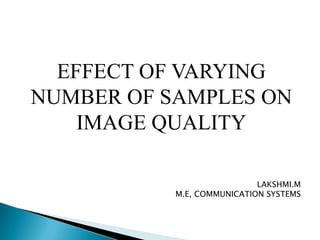Effects of varying number of samples in an image
- 1. EFFECT OF VARYING NUMBER OF SAMPLES ON IMAGE QUALITY LAKSHMI.M M.E, COMMUNICATION SYSTEMS
- 2. SAMPLING Sampling is the first operation done in digitalization of an analog signal followed by quantization Sampling - principal factor determining the spatial resolution of an image. Spatial resolution is the smallest discernible detail in an image.
- 3. SAMPLING UPSAMPLING - INCREASING THE NUMBER OF SAMPLES DOWNSAMPLING - DECREASING THE NUMBER OF SAMPLES
- 4. Upsampling and Downsampling of a discrete signal
- 6. CODE FOR DOWNSAMPLING: clc; clear all; close all; f=imread('cameraman.tif'); y=imresize(f,[1024 1024]); figure; imshow(y); down=y(1:2:end,1:2:end); figure; imshow(down); down1=y(1:4:end,1:4:end); figure; imshow(down1); down2=y(1:8:end,1:8:end); figure; imshow(down2); down3=y(1:16:end,1:16:end); figure; imshow(down3); down4=y(1:16:end,1:16:end); figure; imshow(down4);
- 7. Fig1. 1024*1024 Fig2. 512*512 Fig3. 256*256 Fig4. 128*128 Fig5. 64*64 Fig6. 32*32 DOWNSAMPLED IMAGES
- 8. EFFECT OF VARYING NUMBER OF SAMPLES 256*256 256*256 Downsampled by a factor of 3 Upsampled by a factor of 3
- 9. clc; clear all; close all; f=imread('cameraman.tif'); y=imresize(f,[8 8]); figure; imshow(y); disp(y); display('size of original image:'); l1=size(y); disp(l1); %downsampling down=y(1:2:end,1:2:end); disp(down); display('size of downsampled image:'); l2=size(down); disp(l2); figure; imshow(down); Upsampling the downsampled image % upsampling the downsampled image up=down(1:0.4:end,1:0.4:end); disp(up); display('size of upsampled image:'); l3=size(up); disp(l3); figure; imshow(up);
- 10. Pixel values of original image
- 11. EFFECT OF VARYING NUMBER OF SAMPLES 256*256 256*256 Upsampled by a factor of 3 Downsampled by a factor of 3
- 12. f=imread('cameraman.tif'); y=imresize(f,[4 4]); display('pixel values of original image'); figure; imshow(y); title('original image'); disp(y); display('size of original image:'); l1=size(y); disp(l1); %upsampling up=y(1:0.4:end,1:0.4:end); display('pixel values of downsampled image'); disp(up); display('size of upsampled image:'); l2=size(up); disp(l2); figure; imshow(up); title('upsampled image'); Downsampling the upsampled image %downsampling the upsampled image down=up(1:2:end,1:2:end); display('pixel values of reconstructed image'); disp(down); display('size of reconstructed image:'); l2=size(down); disp(l2); figure; imshow(down);
- 14. Inference: Downsampling provides reduced pixel value image which when zoomed, results in poor image quality In upsampling, no pixel value is removed and hence when downsampled to its original image size, almost the original image quality is obtained.
- 15. THANK YOU






![CODE FOR DOWNSAMPLING:
clc;
clear all;
close all;
f=imread('cameraman.tif');
y=imresize(f,[1024 1024]);
figure; imshow(y);
down=y(1:2:end,1:2:end);
figure; imshow(down);
down1=y(1:4:end,1:4:end);
figure; imshow(down1);
down2=y(1:8:end,1:8:end);
figure; imshow(down2);
down3=y(1:16:end,1:16:end);
figure; imshow(down3);
down4=y(1:16:end,1:16:end);
figure; imshow(down4);](https://image.slidesharecdn.com/sampling-140314164458-phpapp02/85/Effects-of-varying-number-of-samples-in-an-image-6-320.jpg)


![clc;
clear all;
close all;
f=imread('cameraman.tif');
y=imresize(f,[8 8]);
figure; imshow(y);
disp(y);
display('size of original image:');
l1=size(y);
disp(l1);
%downsampling
down=y(1:2:end,1:2:end);
disp(down);
display('size of downsampled image:');
l2=size(down);
disp(l2);
figure; imshow(down);
Upsampling the downsampled image
% upsampling the downsampled image
up=down(1:0.4:end,1:0.4:end);
disp(up);
display('size of upsampled image:');
l3=size(up);
disp(l3);
figure; imshow(up);](https://image.slidesharecdn.com/sampling-140314164458-phpapp02/85/Effects-of-varying-number-of-samples-in-an-image-9-320.jpg)


![f=imread('cameraman.tif');
y=imresize(f,[4 4]);
display('pixel values of original image');
figure; imshow(y);
title('original image');
disp(y);
display('size of original image:');
l1=size(y);
disp(l1);
%upsampling
up=y(1:0.4:end,1:0.4:end);
display('pixel values of downsampled
image');
disp(up);
display('size of upsampled image:');
l2=size(up);
disp(l2);
figure; imshow(up);
title('upsampled image');
Downsampling the upsampled image
%downsampling the upsampled image
down=up(1:2:end,1:2:end);
display('pixel values of reconstructed
image');
disp(down);
display('size of reconstructed image:');
l2=size(down);
disp(l2);
figure; imshow(down);](https://image.slidesharecdn.com/sampling-140314164458-phpapp02/85/Effects-of-varying-number-of-samples-in-an-image-12-320.jpg)


